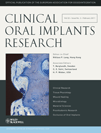Cross-sectional analysis of the mandibular lingual concavity using cone beam computed tomography
Abstract
Objectives: To study the prevalence and the degree of lingual concavity in the edentulous first molar region from cone beam computed tomography (CBCT) scans of the mandibles.
Material and methods: Qualified cross-sectional images in mandibular first molar edentulous region taken from CBCT were selected. The mandible morphology 2 mm above the inferior alveolar canal (IAC) was classified into the convex (C), parallel (P) and undercut (U) type, based on the presence of lingual concavity and the shape of alveolar ridge. The prevalence of each group was determined. Subsequently, the lingual concavity characters, including the depth, the angulation and the vertical location were determined by the measurements of selected anatomic landmarks.
Results: One hundred and three subjects (mean age 51 with a range of 23.7–70.4 years) were studied. The U type was the most prevalent, accounting for 66% of the study population. The mean undercut depth and angulation at the level 2 mm above IAC were on average 2.4 mm and 57.7°. The mean vertical distances from the most prominent point (P) of the lingual concavity to the cemento-enamel junction of second premolar and the inferior border of the mandible were 11.7 and 14.9 mm, respectively.
Conclusions: The anatomic location and the degree of the lingual concavity presented in this article add more information in implant treatment planning in the mandibular first molar edentulous region.
To cite this article: Chan H-L, Brooks SL, Fu J-H, Yeh C-Y, Rudek I, Wang H-L. Cross-sectional analysis of the mandibular lingual concavity using cone beam computed tomography.Clin. Oral Impl. Res. 22, 2011; 201–206.doi: 10.1111/j.1600-0501.2010.02018.x




